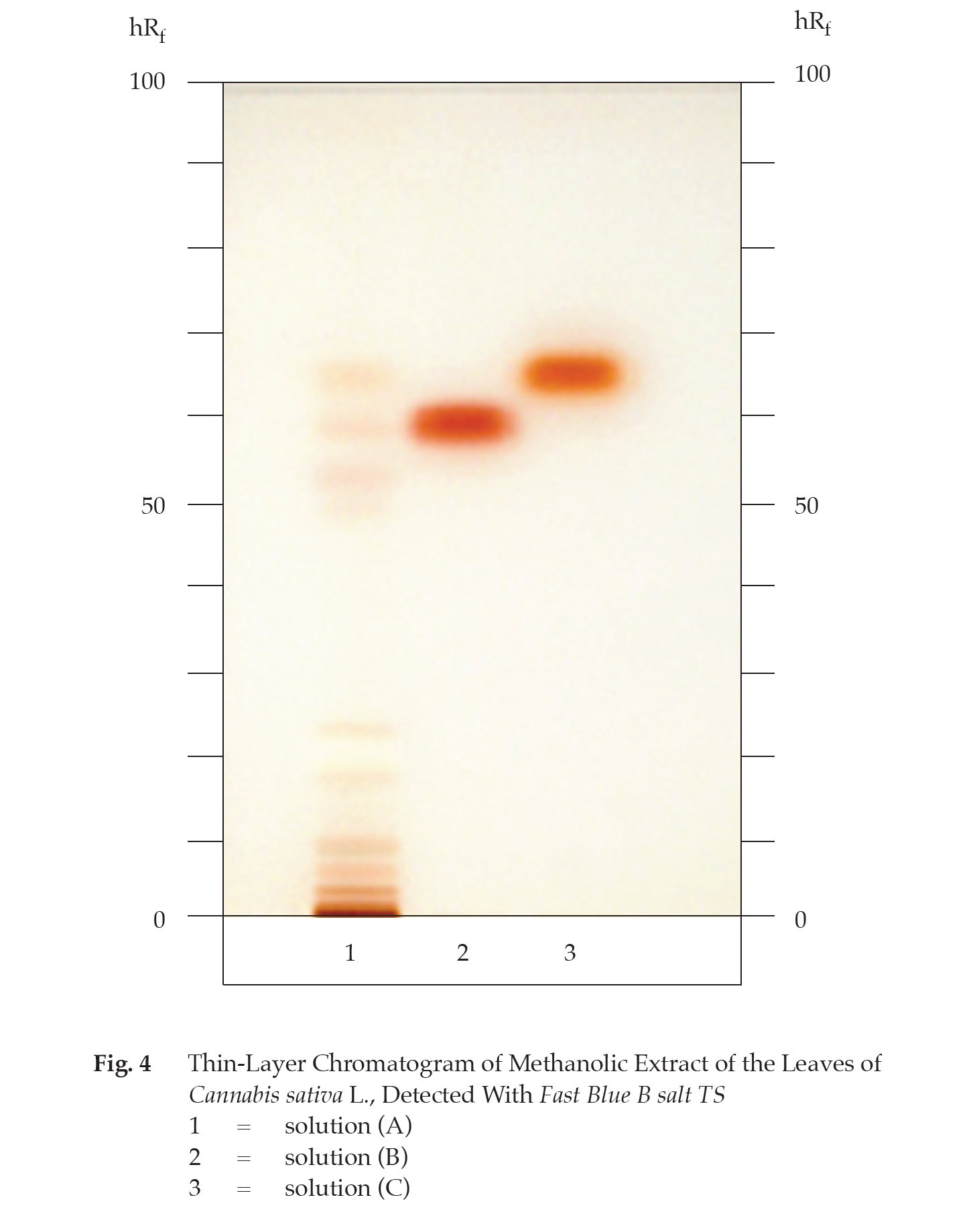ตำรามาตรฐานยาสมุนไพรไทย
Thai Herbal Pharmacopoeia
สำนักยาและวัตถุเสพติด กรมวิทยาศาสตร์การแพทย์ กระทรวงสาธารณสุข
Bureau of Drug and Narcotic, Department of Medical Sciences, Ministry of Public Health(Tinospora crispa (L.) Hook.f. & Thomson)
(Nelumbo nucifera Gaertn.)
(Centella asiatica (L.) Urb.)
(Centella Dry Extract)
(Centella Cream)
(Mesua ferrea L.)
(Piper sarmentosum Roxb.)
(Piper sarmentosum Roxb.)
(Pterocarpus santalinus L. f.)
(Santalum album L.)
(Senna tora (L.) Roxb.)
(Senna alata (L.) Roxb.)
(Senna Alata Tea)
(Piper retrofractum Vahl)
(Myristica fragrans Houtt)
(Andrographis paniculata (Burm. f.) Nees)
(Andrographis Capsules)
(Allium ascalonicum L.)
(Ocimum tenuiflorum L.)
(Curcuma longa L.)
(Turmeric Capsules)
(Turmeric Dry Extract)
(Turmeric Dry Extract Capsules)
(Arcangelisia flava (L.) Merr.)
(Curcuma sp.)
Harrisonia perforata (Blanco) Merr.
(Aristolochia pierrei Lecomte)
(Zingiber officinale Roscoe)
(Ginger Capsules)
(Ginger Tea)
(Cassia fistula L.)
(Nardostachys jatamansi (D. Don) DC.)
(Angelica sinensis (Oliv.) Diels)
Artemisia annua L.
(Ligusticum sinense Oliv. cv. Chuanxiong)
(Neopicrorhiza scrophulariiflora Pennell)
(Atractylodes lancea (Thunb.) DC.)
(Aucklandia lappa Decne)
(Terminalia chebula Retz.)
(Angelica dahurica (Hoffm.) Benth. & Hook. f. ex Franch. & Sav. var. dahurica)
(Kaempferia parviflora Wall. ex Baker)
(Hibiscus sabdariffa L.)
(Roselle Tea)
(Allium sativum L.)
(Zingiber zerumbet (L.) Sm.)
(Wurfbainia testacea (Ridl.) Škorničk.& A. D. Poulsen)
(Cannabis sativa L.)
(Myristica fragrans Houtt)
(Dracaena cochinchinensis (Lour.) S. C. Chen)
(Ficus racemosa L.)
(Hyptis suaveolens (L.) Poit.)
Clerodendrum indicum (L.) Kuntze
(Phyllanthus emblica L.)
(Citrus hystrix DC.)
(Citrus hystrix DC.)
(Areca catechu L.)
(Momordica charantia L.)
Moringa oleifera Lam.
(Aegle marmelos (L.) Corrêa)
(Solanum trilobatum L.)
(Morus alba L.)
Gynostemma pentaphyllum(Thunb.)
Makino
(Clinacanthus nutans (Burm. f.) Lindau)
(Cissus quadrangularis L.)
(Mimusops elengi L.)
(Zingiber montanum (J. König) Link. ex A. Dietr.)
(Piper betle L.)
(Capsicum annuum L.)
(Capsicum Oleoresin)
(Capsicum Gel)
(Piper nigrum L.)
(Piper nigrum L.)
(Eurycoma longifolia Jack)
(Thunbergia laurifolia Lindl.)
(Piper wallichii (Miq.) Hand.-Mazz.)
Senna garrettiana (Craib) H. S. Irwin & Barneby
(Terminalia bellirica (Gaertn.) Roxb.)
(Terminalia chebula Retz.)
(Caesalpinia bonduc (L.) H. Roxb.)
(Tarlmounia elliptica (DC.) H. Rob., S. C. Keeley, Skvaria & R. Chan)
(Hog Creeper Vine Dry Extract Capsiles)
(Hog Creeper Vine Dry Extract)
(Brachypterum scandens (Roxb.) Miq.)
(Lepidium sativum L.)
(Nigella sativa L.)
(Cuminum cyminum L.)
(Foeniculum vulgare Mill.)
(Plantago ovata Forssk.)
(Pimpinella anisum L.)
(Carum carvi L.)
(Anethum graveolens L.)
(Trachyspermum ammi (L.) Sprague)
Albizia procera (Roxb.) Benth.
(Acorus calamus L.)
(Tiliacora triandra (Colebr.) Diels)
Cyanthillium cinereum (L.) H. Rob.
(Orthosiphon aristatus (Blume) Miq.)
Murdannia loriformis (Hassk.) R. S. Rao & Kammathy
(Capparis micracantha DC.)
(Chrysopogon zizanioides (L.) Roberty)
(Cyperus rotundus L.)
(Cannabis sativa L.)
(Syzygium aromaticum (L.) Merr. & L. M. Perry)
(Boesenbergia rotunda (L.) Mansf.)
(Acanthus ebracteatus Vahl)
(Acanthus ilicifolius L.)
(Kaempferia galanga L.)
(Curcuma comosa Roxb.)
Betula alnoides Buch.-Ham. ex D. Don
Cannabis sativa L.
Carthamus tinctorius L
Mitragyna speciosa (Korth.) Havil
Mallotus repandus (Rottler) Müll. Arg
Azadirachta indica A. Juss. var. siamensis Valeton
Azadirachta indica A. Juss. var. siamensis Valeton
Punica granatum L.
Rhinacanthus nasutus (L.) Kurz
Baliospermum solanifolium (Burm.) Suresh
Curcuma aeruginosa Roxb
Boesenbergia kingii Mood & L. M. Prince
Senegalia rugata (Lam.) Britton & Rose
Acacia concinna (Willd.) DC.
Senegalia rugata (Lam.) Britton & Rose
Acacia concinna (Willd.) DC.
Senna alexandriana Mill. var. alexandriana
Cassia acutifolia Delile, Cassia angustifolia Vahl
Butea superba Roxb. ex Willd.
[Plaso superba (Roxb. ex Willd.) Kuntze, Rudolphia superba (Roxb. ex Willd.) Poir.
Pueraria candollei Graham
ex Benth. var. mirifica (Airy Shaw & Suvat.) Niyomdham
Streblus asper Lour.
Suregada multiflora (A. Juss.) Baill. (Gelonium
multiflorum A. Juss.
Cannabis Sativa Leaf is the dried mature cauline leaf of Cannabis sativa L. [C. indica Lam., C. ruderalis Janisch., C. ruderalis (Janisch.) S. Z. Liou, C. sativa subsp. indica (Lam.) E. Small & Cronquist, C. sativa var. indica (Lam.) Wehmer] (Family Cannabaceae), Herbarium Specimen Number: DMSC 5268, Crude Drug Number: DMSc 1193.
Constituents Cannabis Sativa Leaf contains cannabinoids (e.g., cannabidiol or CBD, Δ9-tetrahydrocannabinol or Δ9-THC or THC). It also contains terpenoids, flavonoids, etc.
Description of the plant (Fig. 1) Herbaceous plant, dioecious, occasionally monoecious, 0.2 to 6 m tall; stem and branches angular, erect, covered with rather short stiff hairs. Leaves palmately compound, opposite near base, spirally arranged upwards; petiole up to 10 cm long, pubescent; stipule erect, linear or narrowly subulate, 4 to 6 mm long, persistent; leaflets (3‒)5 to 11, narrowly lanceolate, linear to linear-lanceolate, 2 to 15 cm long, 0.2 to 2 cm wide, apex acuminate-caudate, base narrowly cuneate, margin coarsely serrate, upper surface dark green, scabrous, lower surface whitish green with scattered brownish resinous dots, densely pubescent with appressed hairs, nerves 8 to 20 pairs; sessile. Flowering top numerous inflorescences, terminal or axillary; male inflorescence diffused and paniculate, bracts small; female inflorescence crowded among foliaceous bracts, 1 to 5 cm long. Flower small, unisexual; male flower yellowish green, tepals 5, free, elliptic or oblong, 3 to 5 mm long, 1.5 to 2 mm wide, apex acute, margin entire, finely pubescent; stamens 5, opposite tepals, filament slender, 0.5 to 1 mm long, anther basifixed, oblong, 2-celled, dehiscing by apical pore; female flower greenish, subsessile, enveloped by perigonal bract, membranous spathe-like, dark green, with glandular hairs; tepals fused into thin-textured tube adnate to ovary, in some cultivars, merely a ring at base of ovary; ovary superior, subglobose, 1 to 2 mm in diameter, 1-loculed, style short divided into 2 stigmatic slender arms, brown, pubescent, caducous. Fruit an achene, ovoid or ellipsoid, 2 to 5 mm long, 3 to 4 mm wide, somewhat compressed, minutely pilose to glabrous, shiny, yellowish brown to white or greenish, mottled with purple pericarp crustaceous, finely reticulate. Seed 1.
Description Odour, aromatic, characteristic; taste, bland.
Macroscopical (Fig. 1) Cannabis Sativa Leaf occurs as a mixture of entire and broken, greenish brown leaves. Entire leaves palmately compound with up to 10 cm long stalk, leaflets 5 to 9, linear to lanceolate, apex acuminate, base acute, margin toothed.
Microscopical (Figs. 2a, 2b, 2c, 2d, 2e) Transverse section of the cauline leaf through the midrib shows upper epidermis, mesophyll, vascular tissue, and lower epidermis. Upper epidermis: a layer of rectangular cells, covered with cuticle layer; stomata; short unicellular trichomes with or without cystolith. Mesophyll: a layer of cylindrical palisade cells, some containing rosette aggregate crystals; spongy cells, irregularly shaped, loosely arranged, some containing rosette aggregate crystals or starch grains; angular collenchyma; and parenchyma, some containing rosette aggregate crystals, occurring in the upper and lower parts of the midrib. Vascular tissue: phloem and xylem. Lower epidermis: a layer of small rectangular cells, covered with cuticle layer; raised stomata; long unicellular trichomes with or without cystolith; glandular trichomes with short stalk; clear or cloudy multicellular glandular trichomes.
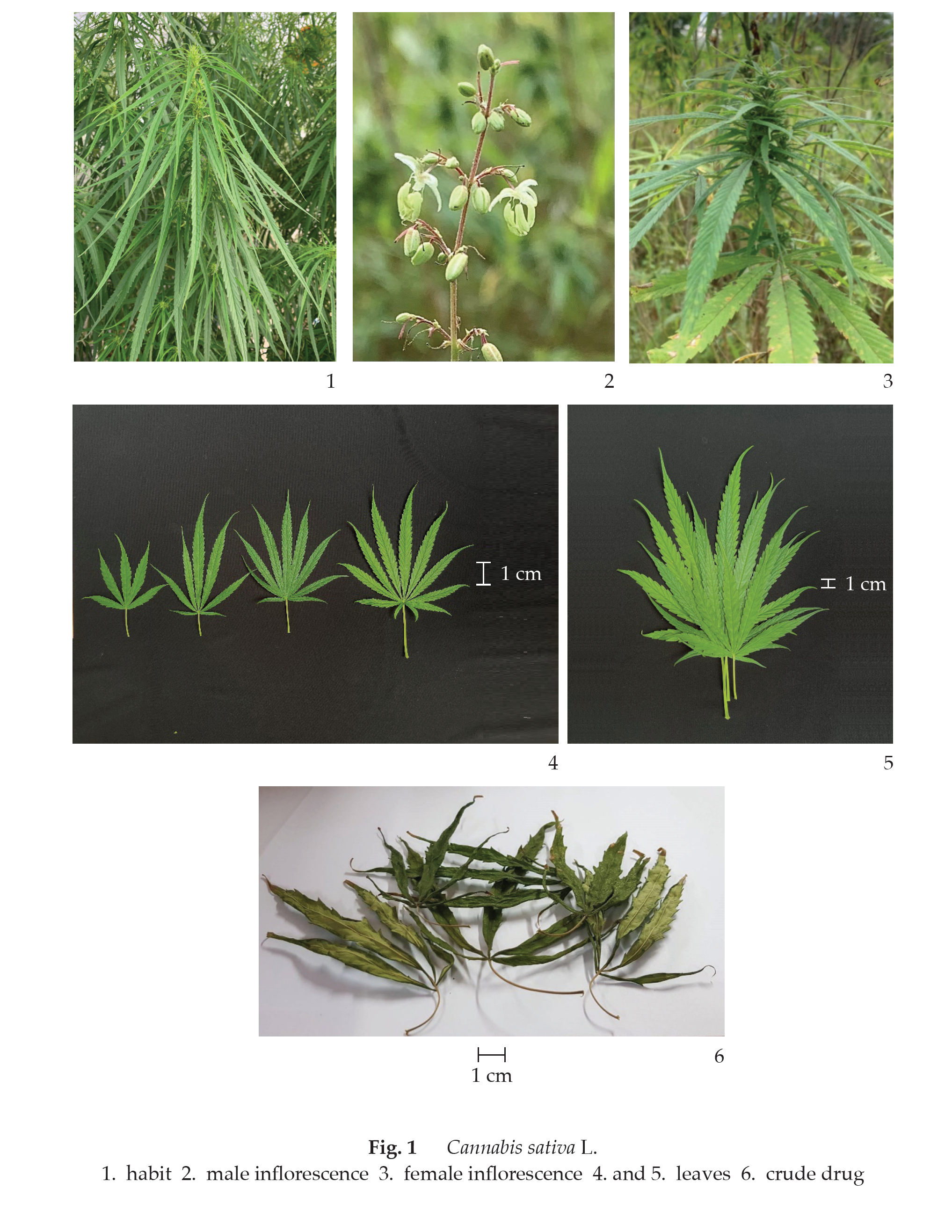
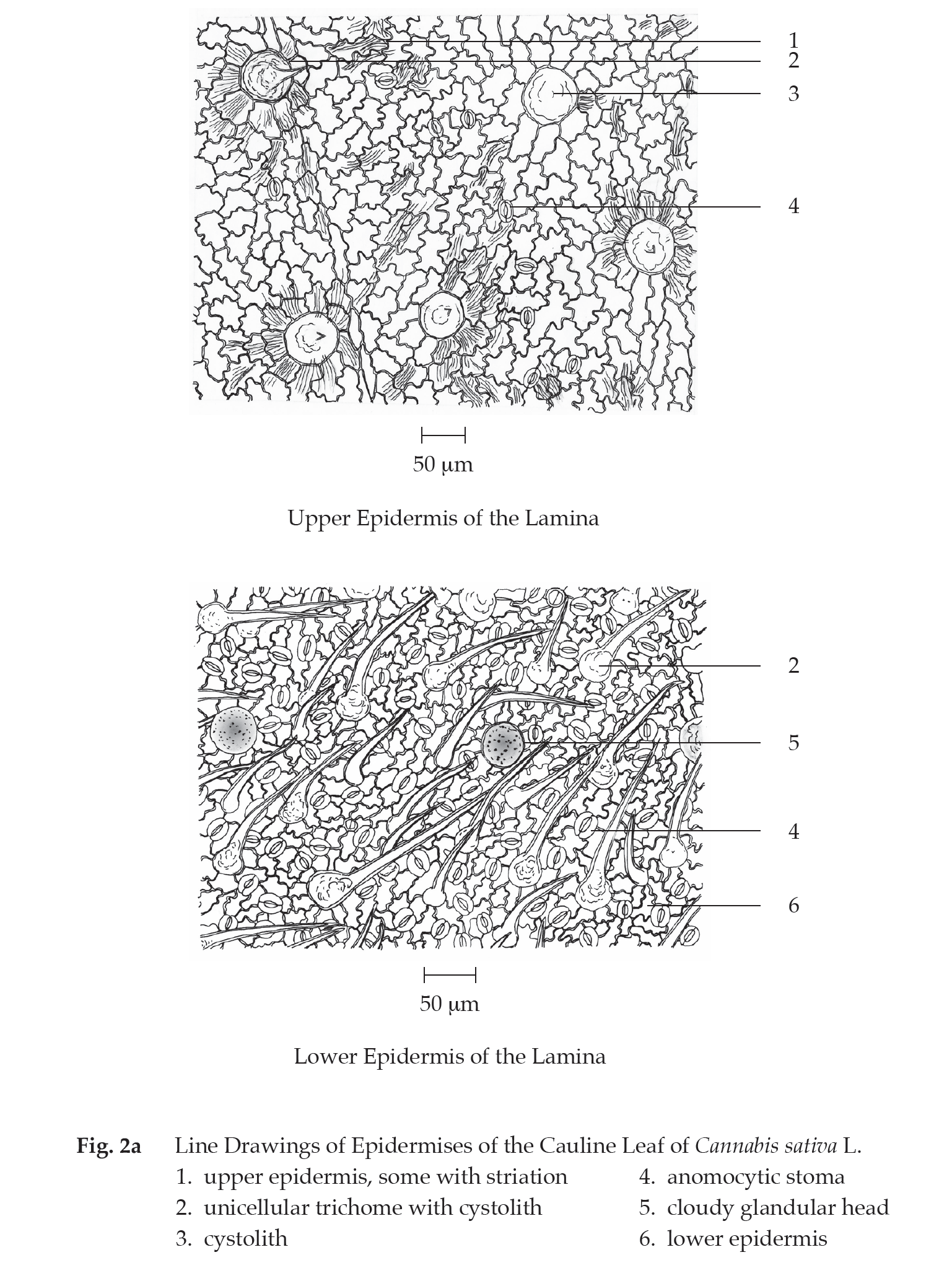
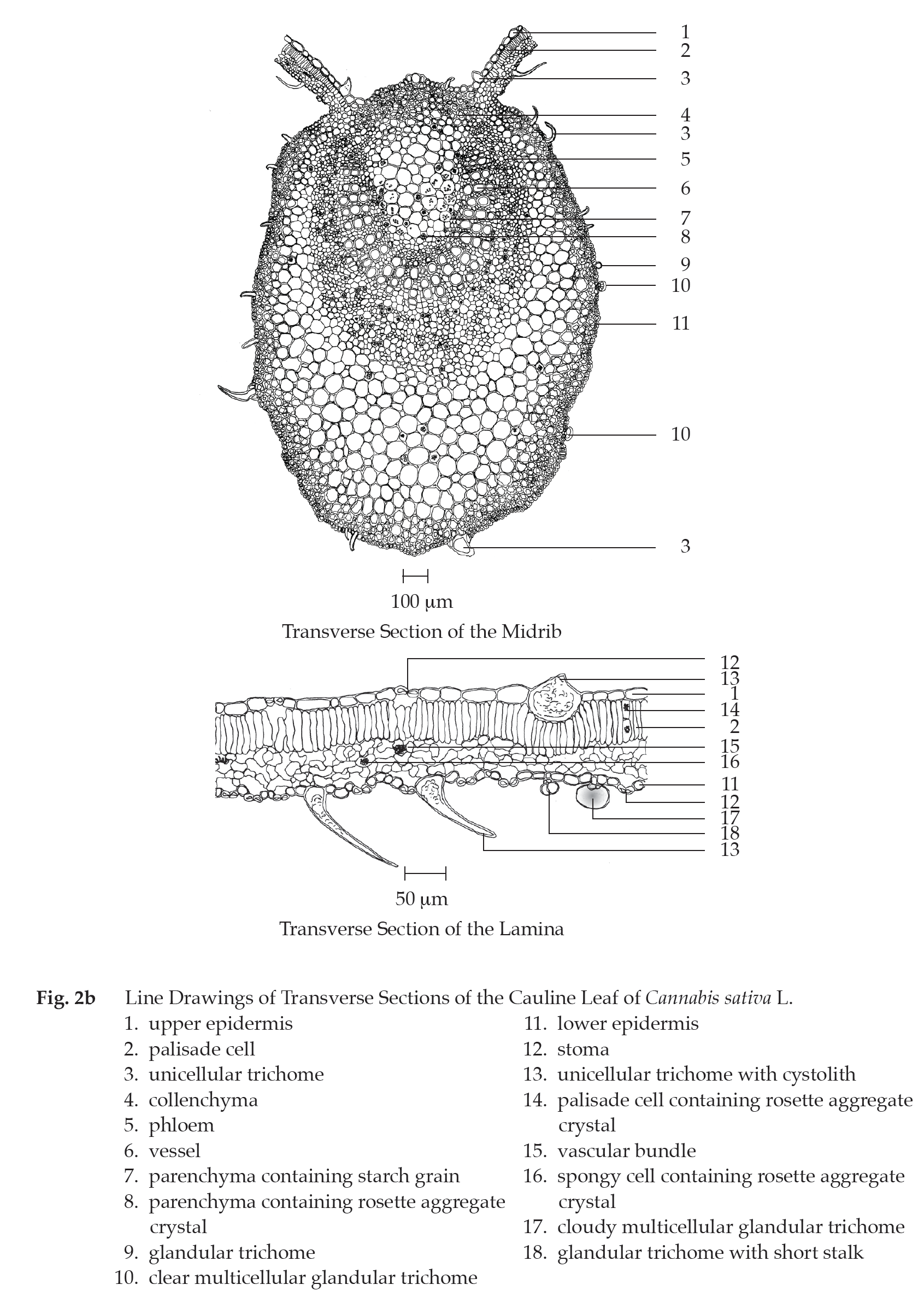
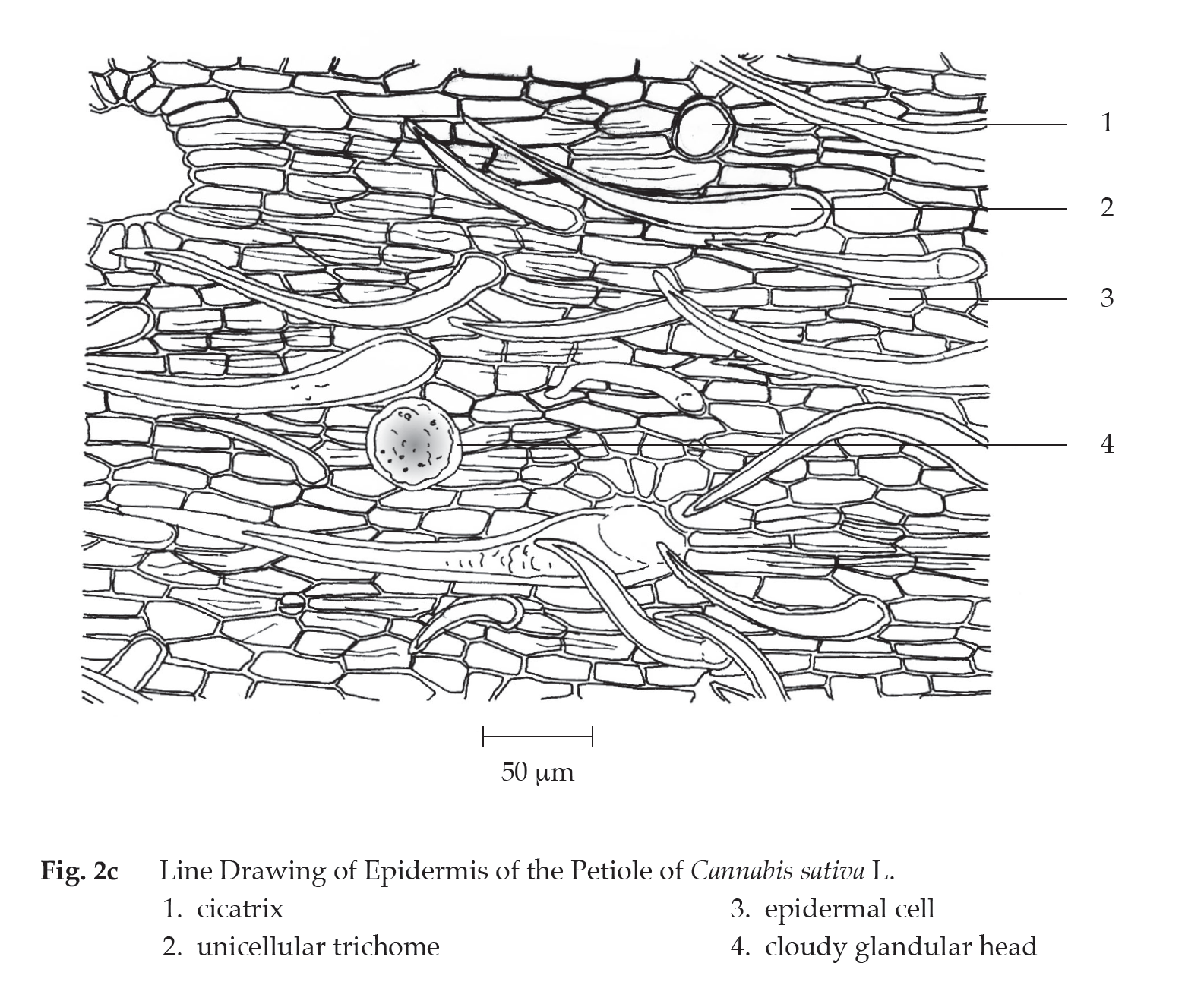
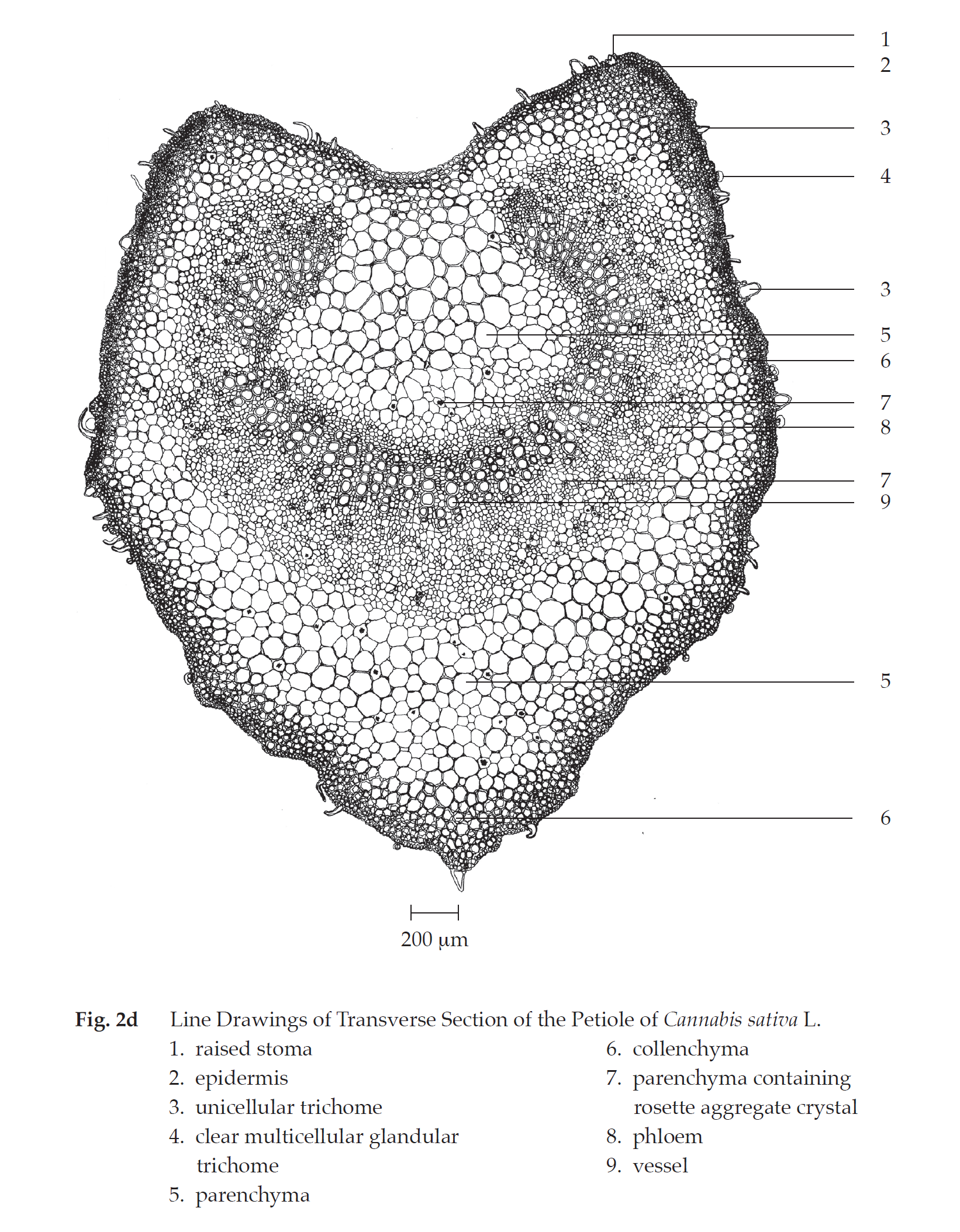

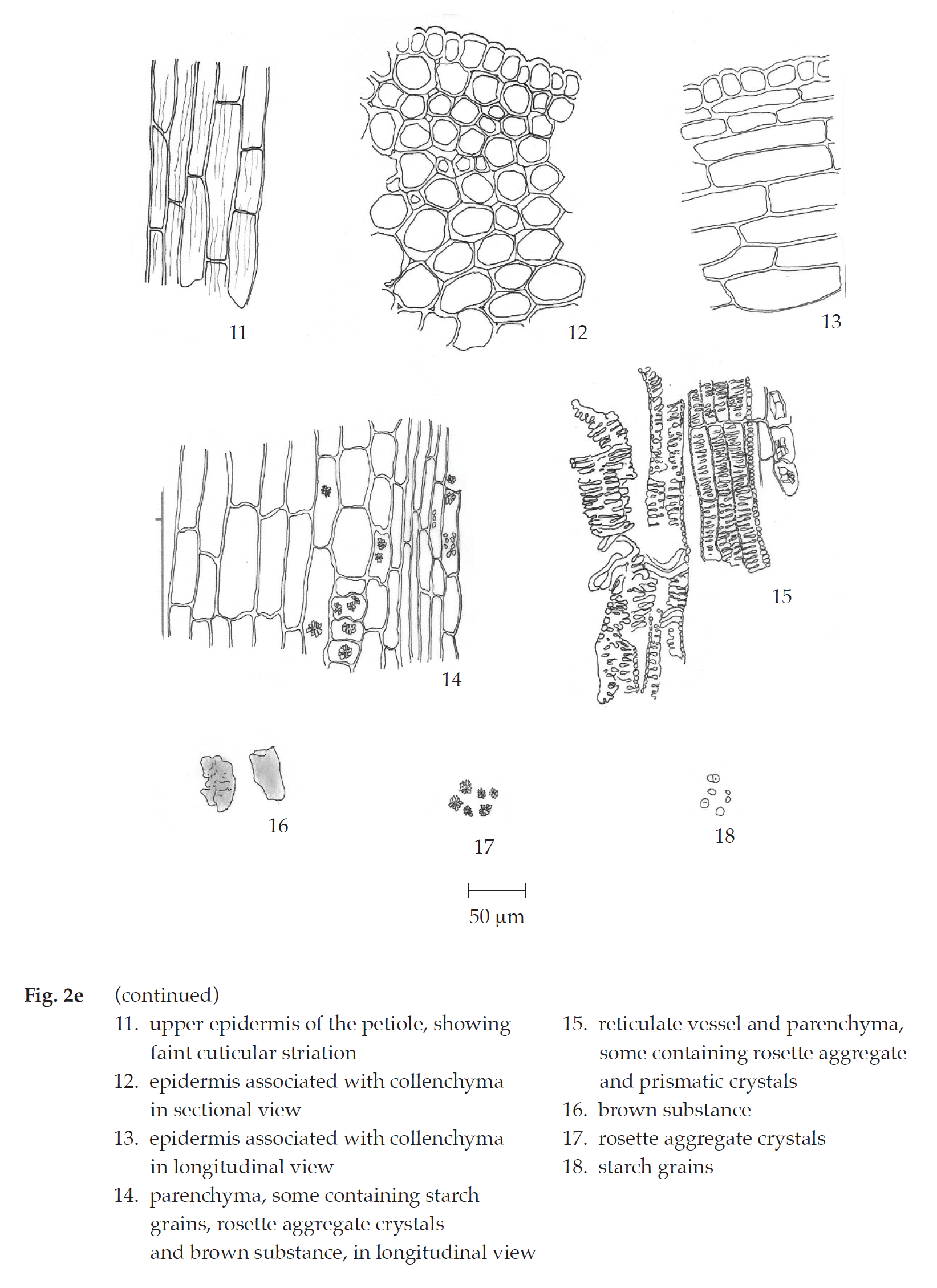
In surface view, the lamina shows upper epidermis and lower epidermis. Upper epidermis: wavy epidermal cells, some with cuticular striation; stomata; short unicellular trichomes with cystolith. Lower epidermis: wavy epidermal cells, raised stomata; long unicellular trichomes with or without cystolith; and cloudy multicellular glandular trichomes.
Transverse section of the petiole of the cauline leaf shows epidermis, cortex and vascular tissue. Epidermis: a layer of small polygonal cells, covered with cuticle layer; raised stomata; unicellular trichomes; clear multicellular glandular trichome. Cortex: angular and lacunar collenchyma; thin-walled parenchyma, some containing rosette aggregate crystals or starch grains. Vascular tissue: U-shaped collateral vascular bundles, phloem and xylem.
In surface view, the petiole of the cauline leaf shows rectangular epidermal cells, cicatrices; unicellular trichomes with or without cystolith; multicellular glandular trichomes.
Cannabis Sativa Leaf in powder possesses the diagnostic microscopical characters of the unground drug. Epidermis with cuticular striation, multicellular glandular trichomes, cystolith trichomes, cloud and clear glandular trichomes, and short cystolith trichomes are characteristic and frequently observed.
Additional information
1. It is commonly used with other herbal drugs in Thai traditional herbal preparations.
2. Under the Notifications of the Ministry of Public Health B.E. 2564 (2021), cannabis sativa leaf, without female inflorescences or flowering tops, can be used in preparing cosmetics or specially controlled foods.
3. It is to be noted that the TLC patterns may vary due to variation in the CBD and THC contents in different cultivars of the cannabis samples.
Packaging and storage Cannabis Sativa Leaf shall be kept in well-closed containers, protected from light, and stored in a cool and dry place.
Identification
A. Macerate 100 mg of the sample, in fine powder, with 10 mL of petroleum ether (boiling range, 60° to 80°) for 10 minutes and filter. Evaporate 1 mL of the filtrate to dryness. Dissolve the residue in 1 mL of methanol. Add 1 drop of Fast Blue B salt TS and 1 drop of a 10 per cent w/v solution of sodium hydrogen carbonate: an orange-red colour is produced.
B. The chromatogram of the Sample preparation shows several peaks, one of which corresponds to the tetrahydrocannabinol peak of the Standard preparations, as obtained in the Tetrahydrocannabinol content (Fig. 3).

C. Carry out the test as described in the “Thin-Layer Chromatography” (Appendix 3.1), using a high-performance plate with silica gel F254 as the coating substance and a mixture of 80 volumes of petroleum ether (boiling range, 60° to 80°) and 20 volumes of ether as the mobile phase and allowing the solvent front to ascend 8 cm above the line of application. Apply separately to the plate, as bands of 7 mm, 10 µL of solution (A) and 5 µL each of solutions (B) and (C). For solution (A), macerate 100 mg of the sample, in fine powder, with 5 mL of methanol, shake for 10 minutes and filter. Solution (B) contains 1 mg per mL of Tetrahydrocannabinol RS in ethanol (Lipomed® or equivalent is suitable.). For solution (C), dissolve 1 mg of Cannabidiol RS in 1 mL of methanol. After removal of the plate, allow it to dry in air and spray the plate with Fast Blue B salt TS. The chromatogram obtained from solution (A) shows a pale red band and a pale orange band due to tetrahydrocannabinol and cannabidiol (hRf values 58 to 60 and 64 to 66), respectively. Two orange and four brown bands are also observed (Fig. 4).
Loss on drying Not more than 9.0 per cent w/w after drying at 105° to constant weight (Appendix 4.15).
Foreign matter Not more than 2.0 per cent w/w (Appendix 7.2).
Acid-insoluble ash Not more than 4.0 per cent w/w (Appendix 7.6).
Total ash Not more than 20.0 per cent w/w (Appendix 7.7).
Ethanol-soluble extractive Not less than 9.0 per cent w/w (Appendix 7.12).
Water-soluble extractive Not less than 22.0 per cent w/w (Appendix 7.12).
Tetrahydrocannabinol content Not less than 0.2 per cent w/w of tetrahydrocannabinol(C21H30O2). Carry out the determination as described in the “Liquid Chromatography” (Appendix 3.5).
Mobile phase A Use acetonitrile.
Mobile phase B Prepare a 0.1 per cent v/v solution of trifluoroacetic acid.
Standard stock preparation Use a solution containing 1 mg per mL of Tetrahydrocannabinol RS in ethanol (Lipomed® or equivalent is suitable.).
Standard preparations Transfer 1.0 mL of Standard stock preparation to a 50-mL volumetric flask, dilute with acetonitrile to volume and mix. Dilute the solution quantitatively and stepwise with the same solvent to obtain five solutions having known concentrations of 2, 4, 6, 8, and 10 μg per mL.
Sample preparation Sonicate about 400 mg of Cannabis Sativa Leaf, in fine powder and accurately weighed, in 20.0 mL of acetonitrile for 20 minutes and filter. Transfer 1.0 mL of the filtrate to a 20-mL volumetric flask, dilute to volume with acetonitrile and mix. Filter through a nylon membrane having a 0.45-μm porosity.
(Note In case the concentration of tetrahydrocannabinol in the Sample preparation is not in the concentration range of standard curve, allow to adjust the volume of the filtrate taken.)
The step gradient of mobile phases is as follows:
| Time (Minutes) |
Mobile Phase A (Per Cent V/V) |
Mobile Phase B (Per Cent V/V) |
| 0 | 55 | 45 |
| 1 | 55 | 45 |
| 9 | 100 | 0 |
| 11 | 100 | 0 |
| 13 | 55 | 45 |
Chromatographic system The chromatographic procedure may be carried out using (a) a stainless steel column (15 cm × 4.6 mm) packed with octadecylsilane chemically bonded to porous silica or ceramic microparticles (2.7 μm), equipped with a similarly packed guard column (5 mm × 3.9 mm) and maintained at a temperature of 35°±1°, (b) Mobile phase at a flow rate of about 1.8 mL per minute, and (c) an ultraviolet photometer set at 228 nm.
To determine the suitability of the chromatographic system, chromatograph Standard preparation having a known concentration of 6 μg per mL, and record the peak response as directed under Procedure and Calculation: the relative standard deviation for replicate injections is not more than 2.0 per cent.
Procedure and Calculation Separately inject about 25 μL each of Standard preparations into the chromatograph, record the chromatograms and measure the responses for tetrahydrocannabinol peaks. Plot the readings and draw the standard curve of best fit: the curve shows the correlation coefficient of not less than 0.999. Inject about 25 μL of Sample preparation into the chromatograph, record the chromatogram and measure the response for tetrahydrocannabinol peak. By reference to the standard curve, calculate the content of tetrahydrocannabinol (C21H30O2) in the portion of the Cannabis Sativa Leaf taken.
